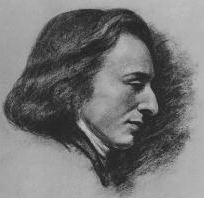The Nocturne is one of the most typical forms of piano music of the nineteenth century and the Romantic music. In this kind of composition the musician writes for the piano keyboard thinking ideally expressiveness that is typical of the human voice.
The romantic Nocturne-form was born, with the Irish composer John Field (1782-1837), but the word was in use in the eighteenth century: But at that time it indicated the musical entertainment of the evening, he could hire the gallant tones of serenade, or those more generally worldly of the fun (the most famous example is "Eine kleine Nachtmusik", "a little night music", by Mozart).
In the nineteenth century, with marvelous examples of Field and then with the Fryderyk Chopin masterpieces (1810-49), the Nocturne becomes the expression of a romantic vision of the world: the night, the darkness become the metaphorical place of desire to exceeding the limit, the soul expand to the dimensions of the dream and the irrational.
We listen to the most famous of the Chopin Nocturnes, op. 9 n. 2 in E-flat Major. Click on the following link: Chopin, Nocturne op. 9 n. 2.
Consider the rhythm of the music: it is a time 12/8, ie a slow pulsation that inside provides a ternary subdivision. More artifices of musical writing are directed to evade and counter any idea of rhythmic rigidity or excessively regular scan: some indications urge the search for phrasing and emotionally moving rhythmically elastic.
The vocal style, as I said at the beginning, is the reference model for the construction of the melody: it is a song (given to the right hand), supported by an accompaniment (left hand), this latter as important and ample, as subordinate and functional to the maximum expansion of lyrical singing. Therefore, it is precisely the same thing that happens when a singer's voice is accompanied by an instrument (for example, the piano itself).
Amples bounds toward the high notes determine the lyricism of this song, we might imagine given to a lyric-coloratura soprano, that is characterized by clear timbre, brilliant of acute and vocal agility.
This agility is made pianistically from Chopin through ornaments and grace notes, that elude the regularity of the musical phrase and culminate in the vaporous, iridescent concluding cadence.
The piano performance requires a piano touch that knows how to satisfy the infinite nuances of sound in his right hand, while the left supports the low harmony and accompanied with a large extension chords.



